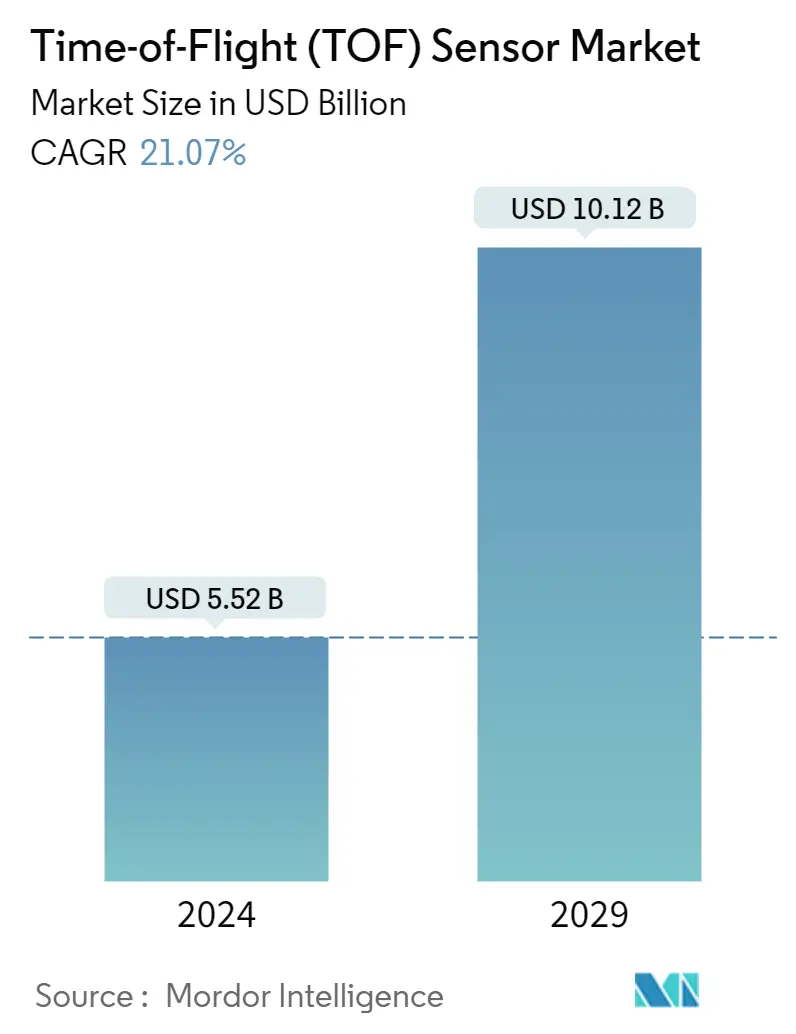Market Size of Time-of-Flight (TOF) Sensor Industry

| Study Period | 2019 - 2029 |
| Market Size (2024) | USD 5.52 Billion |
| Market Size (2029) | USD 10.12 Billion |
| CAGR (2024 - 2029) | 21.07 % |
| Fastest Growing Market | Asia Pacific |
| Largest Market | Asia Pacific |
Major Players_Sensor_Market_.webp)
*Disclaimer: Major Players sorted in no particular order |
Need a report that reflects how COVID-19 has impacted this market and its growth?
Time-of-flight (TOF) Sensor Market Analysis
The Time-of-Flight Sensor Market size is estimated at USD 5.52 billion in 2024, and is expected to reach USD 10.12 billion by 2029, growing at a CAGR of 21.07% during the forecast period (2024-2029).
- The market under study is driven by the rising demand for smartphones equipped with 3D cameras. One of the smartphones' most notable and popular features is their toF cameras. Additionally, it is noted that more people worldwide are subscribing to mobile networks for smartphones. According to Ericsson, smartphone mobile network subscriptions worldwide reached approximately 6.6 billion in 2022 and are expected to surpass 7.8 billion by 2028. The nations with the most smartphone mobile network subscriptions are China, India, and the United States.
- This market's expansion is primarily fueled by rising automotive industry demand for ToF sensors, rising 3D camera use in smartphones, and rising smartphone usage. The market for ToF sensors contains a lot of room to develop because of the expanding use of Industry 4.0 and 3D machine vision systems across various industries.
- As per Edison Investment Research and OICA, forward-facing automotive camera unit sales will increase in Western Europe from 2016 to 2025. By 2025, some 15.5 million forward-facing automotive camera systems are expected to be sold in Western Europe, which also includes 3D cameras altogether.
- Additionally, 3D imaging and scanning will rule the market for ToF sensors throughout the expected timeframe. An object can be turned into a 3D model using 3D scanning technology. The specific area and dimensions of the object are collected, and this mapping data can be used for designing using depth sensing. Future years will see a rise in the adoption of 3D scanning technology because it is easy to use. Time-of-flight technology is an active type of 3D image and scanning technology. Structured light and stereo vision, the other two 3D imaging techniques, are slower, less trustworthy, and use more energy than ToF. ToF technology is anticipated to experience an increase in demand for 3D imaging and scanning applications because of its accessibility.
- TOF technology includes the benefits of long working distances, wide application range, and high distance accuracy. However, there are many disadvantages. For instance, the current mainstream ToF sensor on the mobile phone includes a relatively low resolution (180*240, 240*320, 240*480, etc.), so the accuracy and X/Y resolution in the close range may be relatively low.
- The rising use of cameras in AR and VR may open up new opportunities for the market in post-COVID-19 recovery. Sony Corporation introduced the IMX500, which includes both processing power and memory. This image sensor performs machine learning (ML) and aids in powering computer vision processes without using any external hardware. 3D ToF image sensors could be used in smartphones to provide 3D awareness of the environment for AR/VR applications.
